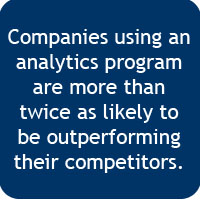 I recently spoke with the CFO of a North American manufacturer who told me that his company had been using the exact same staffing process for the last two decades. It had been inherited through an acquisition and the new CEO at the time trusted the process. Due to recent high turnover and a lack of quality candidates in the pipeline, however, they were considering making changes.
I recently spoke with the CFO of a North American manufacturer who told me that his company had been using the exact same staffing process for the last two decades. It had been inherited through an acquisition and the new CEO at the time trusted the process. Due to recent high turnover and a lack of quality candidates in the pipeline, however, they were considering making changes.
Two things struck me about this situation: first, a lot has changed in the staffing world since the late 1980’s and early 1990’s; and, second, the CEO’s trust seemed to trump a quantitatively-driven evaluation of the process.
Many companies – even after they develop and implement a best in class selection process – do not evaluate it on an ongoing basis. Without taking this step they are failing to determine what’s working and what’s not working and, if the latter, how they might go about making changes.
Indeed, a recent study found that only 34% of companies have an analytics program that evaluates the success of their talent selection program1. This same study found that companies using such a program were more than twice as likely to be outperforming their competitors.
Such a research process will help answer questions like:
- How long does it take to fill roles?
- Which evaluation criteria are the best predictors of successful job performance?
- Does training (for recruiters, hiring managers) improve the quality of new hires?
- Does the onboarding process enhance engagement and decrease turnover?
- Do individual hurdles or the overall process have an adverse impact against protected groups?
In order to set up and maintain this program companies must implement the steps I have been discussing in the Talent Selection blog over the last seven months – in particular:
- Identifying pre-determined, job-related evaluation criteria, including functional competencies;
- Developing and implementing data-driven evaluation techniques; and
- Implementing a standardized and consistent process for all candidates.
The keys to a successful program are multiple. Without these companies will only have anecdotal evidence that systems are working (or not working) properly.
- Stakeholder Identification: Identify and engage your stakeholders – particularly in IT and Operations – on the importance of this initiative. These partners will be critical to how and what talent metrics you focus on, which leads to…
- Data Collection: Collect, track and maintain talent and performance data. Discuss with IT the data that are accessible and currently being collected. Contrast that information with the questions that Operations is most interested in answering. The gap between these two will determine the scope of the work and whether you must collect additional data (e.g., via surveys), which leads to…
- Analytical Proficiency: Hire or develop someone who is proficient in analyzing talent selection and performance data. At a minimum he or she must be able to calculate means and standard deviations as well as conduct correlational analyses, which leads to…
- Results Presentation: Ensure that results are presented in a way that meets the needs of the audience. As a general rule, keep it simple. Your recommendations must be justified by the data but presented in ways that are meaningful to its consumers. For example, District Managers won’t care (or understand) that a particular calculation is “statistically significant”; however, they will understand if you can demonstrate how a new early engagement program has reduced turnover.
 In next month’s blog, I will describe benefits and challenges of connecting talent selection with the onboarding process.
In next month’s blog, I will describe benefits and challenges of connecting talent selection with the onboarding process.
As always, I encourage you to leave your comments and questions in the text box below and to participate in a 3-minute anonymous survey – both of which will help drive discussion and inform subsequent blog posts.
To discuss your specific talent selection issues and challenges, please contact me at 203-817-7522.
[1] Global Selection Forecast 2012

